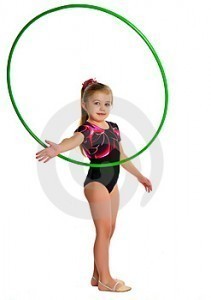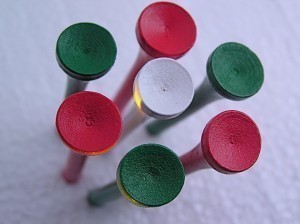Gymnastics Rings Sizes
The gymnastic rings are used in men’s gymnastics.  The goal of the gymnast is to keep the ring as still as possible during the routine.
The goal of the gymnast is to keep the ring as still as possible during the routine.
Sizes of Gymnastics Rings
The rings have a total diameter of 23.6 centimeters (cm). The rings are 28 mm thick. The inner diameter is 18 cm. The distance of the two rings is 50 cm. When measuring the ring height, the 20 cm landing mats must be included. The rings are set 2.75 meters off the floor.
Construction
When used in competition, the rings are usually constructed from wood. For ring training, various types of materials can be used. The rings are also called still rings, as they are supposed to be kept still during the routine.
The gymnastic rings were created by Friedrich Ludwig Jahn. These were originally dubbed Roman Rings because they were said to have originated in Italy.
Use in Competition
The sizes of gymnastics rings as described earlier are the ones used in completion. The routines on the rings are made up of the swing, strength and hold elements. The routines that the gymnasts must perform vary. But most of the time, they have to do a static strength hold, the swing to handstand and also the aerial dismount.
Other gymnasts will do several strength elements. Numerous other holds may be performed with the rings as well. Some of the techniques used by gymnasts are the Inverted Cross, Maltese Cross and Iron Cross. All the movements on the rings must be approved by the Code of Points.
Use in Regular Exercise
The sizes of gymnastics rings used for regular exercises are also the same. Among the routines performed are the dips, pullups, muscle-ups, pushups and variations of these routines. What makes the rings popular is they can be suspended from various locations.
There are also models with adjustable straps. The specifications used in competitions are set by the Federation Internationale de Gymnastique (FIG). The ones used for home use may not necessarily comply with these standards.
Scoring and Penalties
The Code of Points states that the swing, strength and hold components must be in equal amounts. In all international competitions, the performance begins with the still hang. The still hang can be started with the help of a coach. Penalties will be handed out for poor performance.
Penalties will also be given out when any part of the body makes contact with the cables. Point deductions are also given out if the gymnast crosses the cables, falls off the rings or holds for less than two seconds. High scores are attained by gymnasts who perform different moves.
Because of the difficulty in performing the routines, upper body strength is required. The gymnast also has to make sure their grip is firm. The fingers have to be cupped in the ring. The thumbs must be in the forefinger.
The sizes of gymnastics rings used in competitions are standardized. This has made it easier for gymnasts to understand and learn the routines more easily. Nevertheless, a lot of practice is necessary to learn even the most basic moves.





